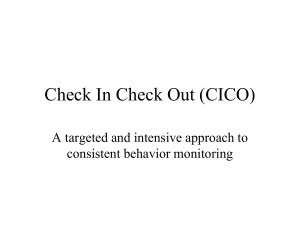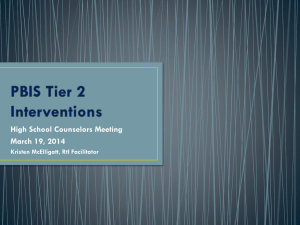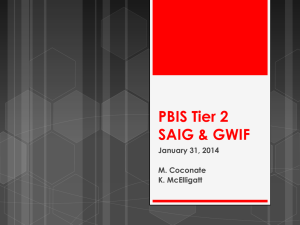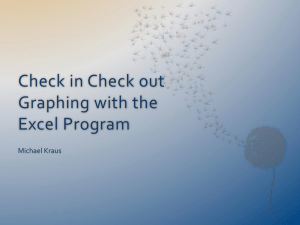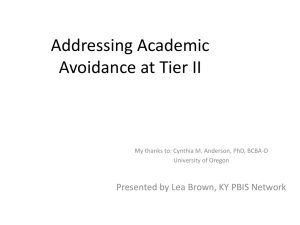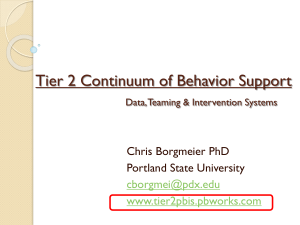CICO - Tier 2 PBIS
advertisement
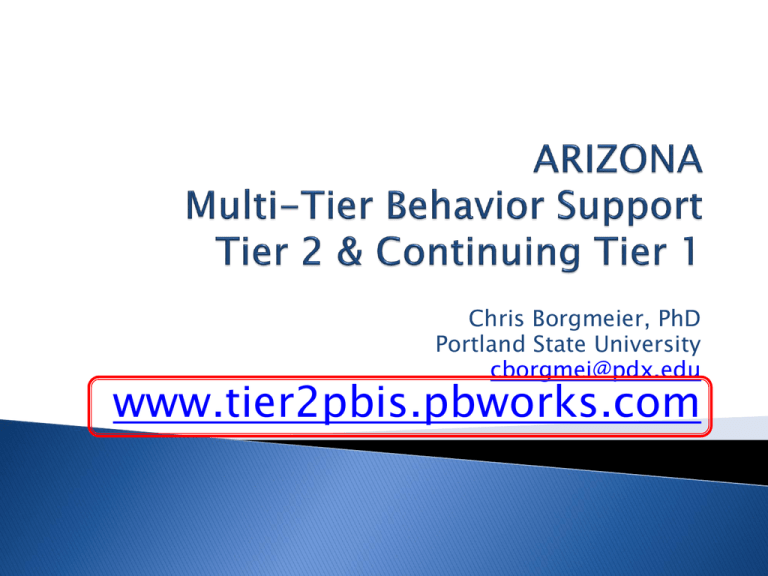
Chris Borgmeier, PhD Portland State University cborgmei@pdx.edu www.tier2pbis.pbworks.com SHOW & TELL Review SW-PBIS Implementation TIPS meeting process ◦ Successes ◦ Surprises ◦ Challenges/Questions Recruit items for Agenda Facilitator Review data prior to the meeting Data Analyst Reserve projector and computer for meeting Keep discussion focused Minute Taker Record Topics and Decisions on agenda/minutes Ensure that problems are defined with precision Ensure that solutions have action plans Provide “drill down” data during discussion End on time Minute taker Prepare minutes and send to all members Minute taker Facilitator Facilitator Facilitator Data Analyst www.uoecs.org Person Responsible Facilitator TIPS II Training Manual (2013) Reserve Room Action Facilitator 3 Where in the Form would you place: 1.Staff will complete weekly fidelity checks 2. Three students are not meeting daily CICO goal 3. Parents are not signing CICO home report 4.ORF scores are too low for third graders 5. Plan for school board report Go to www.pbisassessment.org Enter your school code Reference the MATT handouts to guide you through questions ◦ Coaches Interview Guide (pp. 2-5) ◦ Team Scoring Guide (pp. 6-10) Enter scores into www.pbisassessment.org Chris Borgmeier, PhD Portland State University cborgmei@pdx.edu www.tier2pbis.pbworks.com All specialized interventions are more effective, and more durable, if they are done with school-wide behavioral expectations as a foundation. 5% ~15% Primary Prevention: School/ClassroomWide Systems for All Students, Staff, & Settings SCHOOL-WIDE POSITIVE behavior SUPPORT ~80% of Students Pre schools Sandy Chafouleas, et al 2007 Elementary Schools ◦ ◦ ◦ ◦ ◦ ◦ Middle Schools ◦ ◦ Anne Todd et al in press Sarah Fairbanks et al, 2007 Amy Kauffman-Campbell, dissertation Doug Cheney et al, 2006; 2007 Leanne Hawken et al. 2007 Filter et al., 2007 Leanne Hawken et al 2003 Rob March et al 2002 High Schools ◦ Jessica Swain-Bradway, in progress CICO is an Evidence-Based Practice 1. At least 5 peer reviewed studies 2. At least 3 different researchers/settings 3. At least 20 different participants OREGON 2011-12 CICO-SWIS TIER 2 CICO-SWIS IN OREGON 2011-12 Elem MS HS Pre-8th Others TOTAL Schools 114 35 1 6 1 157 Students 2001 674 33 97 66 2871 >=80% Elem 1750 MS 510 HS 20 K-8 78 Other 57 TOTAL 2415 Over 84% of CICO students succeeding! What constitutes a Tier 2 Intervention? ◦ An intervention that: Serves multiple students at one time (15-25 student at once) More efficient use of resources that 1 student at a time Students can get started with almost immediately upon referral Requires almost no legwork from referring staff to begin implementation of the intervention with a student All school staff know about, understand their roll with, and know the referral process for ◦ SYSTEMS NOTE: Resources Required: If program is not self-sufficient… and requires significant organization by referring staff… it’s not a targeted intervention Intervention is continuously available Rapid access to intervention (72 hr) Very low effort by teachers Consistent with school-wide expectations Implemented by all staff/faculty in a school Flexible intervention based on assessment ◦ Functional Assessment Adequate resources (admin, team) ◦ weekly meeting, plus 10 hours a week Student chooses to participate Continuous monitoring for decision-making Improved structure Prompts are provided throughout the day for correct behavior. System for linking student with at least one positive adult. Student chooses to participate. Student is “set up for success” First contact each morning is positive. “Blow-out” days are pre-empted. First contact each class period (or activity period) is positive. Increase in contingent feedback Feedback occurs more often. Feedback is tied to student behavior. Inappropriate behavior is less likely to be ignored or rewarded. Program can be applied in all school locations Classroom, playground, cafeteria (anywhere there is a supervisor) Elevated reward for appropriate behavior Adult and peer attention delivered each target period Adult attention (and tangible) delivered at end of day Linking behavior support and academic support For academic-based, escape-maintained problem behavior incorporate academic support Linking school and home support Provide format for positive student/parent contact Program is organized to morph into a self-management system Increased options for making choices Increased ability to self-monitor performance/progress Student Referred for CICO CICO Plan/ Initial Meeting Teach/Role Play Skills Check In Check Out (CICO) CICO Coordinator Summarizes Data For Decision Making Morning Check-in Parent Feedback BASIC CYCLE Regular Teacher Feedback Bi-weekly Progress Monitoring Meeting Afternoon Check-out Revise Program Exit Program 1. Faculty and staff commitment Is problem behavior a major concern? Are staff willing to commit 5 min per day? Is CICO a reasonable option for us? More CICO CICO CICO than 5 students need extra support is designed to work with 10-12% of kids in a school typically “works” (50% reduction) with 67% of students. Activity 1: individualized supports. does NOT replace need for a) Assessment of need (ODR rates, staff assessment) b) Readiness: Is SWPBIS Tier 1 in place? (TIC = 80%; SET = 80/80) Is there faculty commitment to work with tougher kids? Are in-school resources available to implement? Are district resources available to support start-up? c) Team to manage CICO • Administrator; CICO Coordinator; Check In/Out staff member(s), behavior Specialist (e.g. SPED/SPSY), Teacher Complete the CICO SelfAssessment & Identify Actions for improved implementatio n http://www.youtube.com/watch?v=UqMdy5-OSlQ Student Recommended for CICO CICO Plan Morning Check-In Class Check out Morning Check-In •Check student “status” •Review home card Weekly CICO •Provide Daily Progress Rpt •Greet andMeeting praise 9 Week Graph Sent Teacher Program Teacher Checks Checks Update Home CheckIn Class Check in Afternoon Checkout •Student give card to teacher •Teacher praise/ prime •Provide Daily Progress Rpt •Greet and praise •End of class feedback EXIT 5. Morning Check-in Routine Teaching students when, when, how Teaching check-in coordinator Assess Reward provided for checking-in; breakfast treat, etc. Set-up or Redirect 6. Teacher Check-in/Check-out Routine Teaching staff/faculty Reward Set-up for success, positive momentum Evaluation Activity 5: a) Identify Check-in staff & location b) Define Check-in routine & how to train check-in staff c) Teacher check-in/check-out routine defined Leading Systems Implementation Coordinator Chair CICO meetings, faculty contact, improvement Specialist Check-in, check-out, meeting, data entry, graphs Together (Coordinator + Specialist) = 10 hours/wk Meeting 45 min per week Coordinator, Specialist, Sped faculty, Related Services All staff commitment and training Simple data collection and reporting system. WHAT FITS YOUR SCHOOL? Combining these roles/ responsibilities across multiple staff or not? 1. Who would be a good coordinator? 2. What duties/responsibilities will he/she have? 3. Do we need to adjust schedules/time/ workload for this person? 4. How will we train the coordinator? 5. How will we evaluate the coordinators effectiveness? 6. Who will be our back-up coordinator? 7. What steps do we need to take to accomplish this? Establish rapport with students Provide training to all students before they begin CICO Coordinate check-in and check-out ◦ Possibly do Check-in & check-outs Enter data daily (or monitor daily data entry) Organize and summarize student data for meetings Contact person for caregivers Process requests for assistance Lead meetings Problem-solve Examples Social worker Counselor Special Education teacher Paraprofessional Non-Examples Principal Classroom teacher Any individual responsible for discipline The coordinator should receive training in the systems, practices, and the use of data in the CICO program. Connect w/ your District & Regional Coaches Be sure to train a “back-up” coordinator Plan for turn-over in the coordinator position Increasing sustainability ◦ Document all procedures ◦ Active management from the leadership team ◦ Write coordinator duties into a job description ◦ Devote FTE to the coordinator position These individuals only do check-in/check-outs w/ students only (data and organization is the CICO Coordinator’s responsibility) - School custodian - School office staff members - “Specials” teachers In the building everyday Available at the beginning and end of each day Someone students like and enjoy being around Enthusiastic Organized Positive The effectiveness of implementation should be examined on a regular basis Evaluation Questions: 1. Does the coordinator establish positive rapport with students? 2. Does the coordinator display effective behavior management skills? 3. Does the coordinator’s position allow all tasks to be completed in a timely manner? 4. Is the coordinator implementing the intervention with fidelity? ◦ CICO Self Assessment, Benchmarks of Advanced Tiers, etc. ◦ Integrate CICO implementation fidelity within a district evaluation plan 2. Team available / Coordinator available CICO Coordinator CICO Specialists (checking in & out w/ students daily) Team (meets at least once every two weeks) Activity 2: Plan CICO Roles & Responsibilities a) CICO Coordinator b) CICO Specialist(s) • Who is doing daily Check-ins & Check-outs? c) behavior: Individual Student Systems Data Team meetings • Training Day 2 Use a School name, mascot, motto ◦ ◦ ◦ ◦ ◦ ◦ Sunshine Club Hawk Report HUG – Hello, Update, Goodbye CnC – Check-n-Connect CICO – Check-In/Check-Out BEP – behavior Education Program Try to use 1 card for the program ◦ Use common schedule if possible ◦ Use School-wide Rules Keep it simple ◦ Card needs to be quick & easy for staff to complete ◦ Card needs to be small (half sheet) & easy to carry around Name: Date: Block 1 Block 2 Block 3 Block 4 Safety 0 1 2 0 1 2 0 1 2 0 1 2 Organization 0 1 2 0 1 2 0 1 2 0 1 2 Achievement 0 1 2 0 1 2 0 1 2 0 1 2 Respect 0 1 2 0 1 2 0 1 2 0 1 2 Name: Date: Pencil sharpened Homework completed Raise hand to Be on time talk Keep hands to self 1. Check in 2. 3. Music on MWF 4. PE on T TH 5. Math 6. Lunch 7. Recess 8. 9. Language arts 10. Snack 11. Research projects 1 2 3 4 1 2 3 4 1 2 3 4 1 2 3 4 1 2 3 4 1 2 3 4 1 2 3 4 1 2 3 4 1 2 3 4 1 2 3 4 1 2 3 4 1 2 3 4 1 2 3 4 1 2 3 4 1 2 3 4 1 2 3 4 1 2 3 4 1 2 3 4 1 2 3 4 1 2 3 4 1 1 1 1 1 1 1 1 1 1 1 1 1 1 1 1 1 1 1 1 1 1 1 1 1 2 2 2 2 2 3 3 3 3 3 4 4 4 4 4 1 2 3 4 1 2 3 4 2 2 2 2 2 3 3 3 3 3 4 4 4 4 4 1 2 3 4 1 2 3 4 2 2 2 2 2 3 3 3 3 3 4 4 4 4 4 1 2 3 4 1 2 3 4 2 2 2 2 2 3 3 3 3 3 4 4 4 4 4 1 2 3 4 1 2 3 4 2 2 2 2 2 3 3 3 3 3 4 4 4 4 4 1 2 3 4 1 2 3 4 Too complicated… Too many ratings Younger children (K-1st grade) ◦ Less words, more pictures ◦ More frequent checks during day ◦ Earn rewards more often CICO Home Report Name: _____________________ ______ I met my goal today Date: _____________ ______ I had a hard day One thing I did really well today was:_______________________ Something I will work on tomorrow is: _______________________ Comments: Parent/Guardian Signature: ________________________________________________________ Comments: 7. Daily CICO progress report card Same expectations for all Common schedule All staff taught rules for accepting, completing and returning the card. 8. Home report process Can be same as progress card or a separate reporting form Activity 6: a) Daily Progress Report developed b) Home report routine developed c) Define how families will be informed of process Student Referred for CICO CICO Plan/ Initial Meeting Teach/Role Play Skills BASIC CYCLE Request for Assistance ODR Level Family or Student request Check In Check Out CICO Coordinator (CICO) behavior support team CICO Coordinator Summarizes Data For Decision Making Morning Check-in Parent Feedback Regular Teacher Feedback Bi-weekly Progress Monitoring Meeting Afternoon Check-out Revise Program Exit Program Multiple office referrals ◦ ID at-risk students at beginning of school year based on previous years data ◦ ID students based on cumulative ODR in school year Referral ◦ by teacher Teacher Request for Assistance ◦ by parent Time to action: ◦ 30 min to 7 days (goal is < 72 hours) More than a minimum number of referrals Across several different settings Not dangerous to self/others Several minor referrals Adult attention is rewarding ◦ Disruptive ◦ Tardy ◦ Talks out ◦ Defiant ◦ Unprepared ◦ Refuses to do work ◦ Talks back to teacher ◦ Uses inappropriate language ◦ Difficulty taking turns ◦ Refuses to share ◦ Out of seat Dangerous/violent students Students who bring a weapon to school Students who injure/may injure themselves Students with a high number of referrals Students with referrals from only one setting, teacher, or time Students who find adult attention aversive George • 17 referrals • From multiple classrooms, cafeteria, hall, and bus Richard • 5 referrals John • 5 referrals • From playground • 2 from classroom, 2 • Defiance, from hall, 1 from inappropriate bus language • Disruption, • Disruption, defiance, fighting defiance, tardy, harassment • Caught with box opener Start the year by reviewing last years data: CICO can help to start the year off on the right foot Office Discipline Referrals - Typically referrals are examined every 2 weeks in a team meeting (school-wide, CICO team, etc.) - Set Decision Rules - Students with 2nd referral = TEAM REVIEW - MS & Elem may have different criterion - Print out an individual student report (SWIS) for each identified student to examine patterns (location, time, problem behavior, etc.) Develop a system Teach staff how to use the system Provide verbal and written instructions on the referral system Respond to referrals in a timely manner System must be efficient 1. 2. 3. 4. 5. How will we examine ODRs? How will we integrate academic data? How often? Is there other data that we will use for screening? What criteria will be use to determine if the student is appropriate for CICO? 6. What will happen after we determine a student is identified as needing CICO? 1. How will teachers refer students (form, email, etc.) & who will the referral go to? 2. What data is needed after the referral is received & who will gather it? 3. How will we determine if a student is appropriate for CICO? 4. How will we inform teachers of this process? 5. What is our anticipated time frame for examining and acting upon referrals? 6. What will we do if a student does not appear to be a good fit? 3. Process for identifying a student who may be appropriate for CICO Student is not responding to SWPBS expectations Request for Assistance Student finds adult attention rewarding Student is NOT in crisis. Activity 3: a) Develop a Request for assistance process defined. b) Define criterion for CICO support (Decision Rules) BASIC CYCLE Student Referred for CICO CICO Plan/ Initial Meeting Teach/Role Play Skills Check InAgreements Check Out Initial Meeting/ -Roles & Responsibilities (CICO) -Teaching CICO Coordinator Summarizes Data For Decision Making Morning Check-in Parent Feedback Regular Teacher Feedback Bi-weekly Progress Monitoring Meeting Afternoon Check-out Revise Program Exit Program How do you want to accomplish this? ◦ Formal meeting? – other communication? Needs before starting the program ◦ Parental permission ◦ Student agreement ◦ Clear understanding of the program & agreement to individual Roles/ Responsibilities Parents Student CICO Coordinator or Specialist(s) Teacher/Staff? School team ◦ Identify students who may benefit ◦ Monitor implementation ◦ Evaluate effects and modify/fade as needed Coordinator ◦ Facilitate morning and afternoon checks (in & out) ◦ Get signed form from students, give new form ◦ Maintain positive, constructive environment ◦ Acknowledge successes Teachers ◦ Obtain form from student each day ◦ Monitor student behavior and mark card accurately ◦ Provide feedback to student in positive and constructive manner Students ◦ Check in and out each day ◦ Give form to teacher ◦ Meet expectations ◦ Take form home and have parents sign, bring to school the next day Be interested, encouraging & supportive Identify Incentives your child can earn at home for performing well on CICO (daily &/or weekly) ◦ Incentives need to be reasonable and something parents can regularly deliver VERY IMPORTANT!!! Do NOT use punishers if your child does not meet his/her goal ◦ if you do your child will not continue with the program… or will not bring reports home to parents ◦ Just encourage your child: “Too bad today, but if you try hard you’ll do better tomorrow!” Before School After School – ◦ Try to reduce “Tough Mornings” before school ◦ Encourage & Support behavior & School Readiness ◦ Request to see student’s home report! ◦ Provide incentives (if the student has earned it), or encouragement Agreement to succeed ◦ ◦ ◦ ◦ Student: Student chooses to participate Parent CICO coordinator Teachers Contract may be written or verbal ◦ Better if written Teach program logistics ◦ Responsibilities: Student, Teacher, Coordinator ◦ Where & with Whom to Check-in & Check-out Teach Desired behaviors Teach Point Card & Rating ◦ What behaviors = 0/1/2 ◦ Role Play w/ student ◦ Have student be teacher & score your behavioral examples 4. Establishing Agreements & Communicating Roles & Responsibilities Permission to Participate Communicating Roles & Responsibilities Parent, Student Teaching Student Program Logistics Teaching Student Expected behaviors & Point Card Activity 4: a) Develop a plan for communicating agreements, roles & responsibilities w/ parent & student • Will you hold an initial meeting? Develop a contract? b) Identify how student will be taught program logistics & behavioral Expectations Student Recommended for CICO CICO Home Check •Student Plan give card to parent Morning •Parent praise/ prime Check-In •No negatives Class •Parent signs Weekly CICO Meeting 9 Week Graph Sent Check out Home CheckIn Class Afternoon checkout Check in •Review day •Retrieve card Afternoon Check•Send copy to family out •Record points in SWIS •Provide incentive if earned Teacher Checks Program Update EXIT Levels of Rewards: o Reward student for: • • Checking-In positive adult interaction & a breakfast snack? Checking-out & turning in daily progress card positive adult interaction & bonus point on card or a piece of licorice? ◦ Earning points & making goal Make sure rewards are feasible & valued Might start with daily rewards for success… then fade to turning in points earned CICO Trading Post Points Required Wants attention note to office/teacher Ask a peer to play/read/draw Be a leader Principles recess Trip 250 pts Computer More 400 pts Out 100 pts Take Wants item/activity with a friend Extra sharing time to lunch with TBA Class recess, free time, or popcorn party to treasure chest Choose a snack Choose a 5 min. activity School wide sticker Principles recess time for selected activity Free ticket to sporting event New school /art supplies Wants to escape attention Computer by self Time time alone Independent work space Wants to avoid something Short break Alternative activity Alternative assignment Get out of school early CICO Trading Post Maintaining Consequence 100 pts 250 pts 400 pts Wants Attention Complete assignment with a peer Wants something Wants to escape attention Wants to something Choose a snack / tangible Computer time by self Short break Choose a 5 min. activity Work in separate part of room Alternative activity Time alone Alternative assignment Chose order of class activities School wide reward card Class teaching assistant for a period. More time for selected activity Lunch for peer and student for FREE New school /art supplies Class reward: free time, or pizza party Free ticket to sporting event / dance / etc. avoid Independent work space Get out of school early 9. Afternoon Check-out Routine Identify Check-out Staff, Location & How to Check-out Teach Check-out staff to collect data, acknowledge success, encourage improvement. Consider self-recording system for older students 10. Trading menu Reward for collecting and turning in daily progress card Reward for meeting daily goal Exchange system for points earned Activity 7: a) End of day check-out routine, location, staff defined. b) Plan Rewards for: Check-in & out; meeting goal, etc. An effective Data System is CRITICAL Highly recommend CICO-SWIS ◦ www.swis.org ◦ Additional $50/year with SWIS account ◦ Cannot get CICO add-on without having SWIS account Alternative = managing excel spreadsheets ◦ Gets challenging with many students ◦ CICO Coordinator must have substantial expertise in Excel Identify who will enter the data daily ◦ CICO Coordinator or CICO Specialist ◦ Train in CICO-SWIS accordingly & provide w/ account passwords Can show student updated graph during check-out 11. Collecting, summarizing and using data Daily updates Coordinator does regular data checks to make sure data is being entered promptly & correctly Activity 8: a) Process for collecting, entering, summarizing and reporting data is defined Team will use data to monitor student progress ◦ Some students will “graduate” from the program ◦ Some students will require the support on a continuing basis ◦ Some students will not respond to the program & need more or something different Set up processes for: ◦ Fading students off of the program ◦ Escalating intensity of intervention ◦ Maintain & monitor The GOAL is always to “Graduate” students from our supports or Fade supports ◦ Do so gradually & Support the Transition 1) Increasing student responsibility Transition into a Self-Management/ Self-Monitoring program 2) Then, gradually removing or “Fading” components of the intervention Student monitors own behavior Student “checks in” with teacher to review self-ratings and receive feedback 1. 2. 3. 4. 5. Expected behaviors stay the same Reinforcers stay the same Student checks in same amount of times Student monitors behavior using CICO card Plan for teaching accuracy in monitoring 1. 2. 3. 4. 5. Student and teacher record separately Compare records; reinforce accuracy Over time, compare less often Reinforce appropriate behavior only Periodically reinforce accuracy Lucy has been on CICO for 3.5 months; she has earned 90% of points each week for the last 10 weeks Coordinator provides rationale for self monitoring to Lucy ◦ Coordinator teaches Lucy to self monitor using examples and nonexamples ◦ When program begins, Lucy’s teacher goes over examples and nonexamples ◦ First week: Lucy and teacher monitor and compare records Teacher provides acknowledgement and feedback based on accuracy Ratings agree 95% of time ◦ Second week Teacher monitors appx. 60% of time; feedback based on accuracy Feedback at other times based on Lucy’s monitoring of behavior ◦ Coordinator Feedback based on accuracy (with teacher records) When Lucy monitors independently, feedback based on behavior After Student is Successfully Self-Monitoring Can begin removing components of the program (removing staff responsibility) ◦ Gradually decrease # of check-ins during the day w/ teachers; Student Self Checks (keep check in and out) ◦ Fade from Daily check out to every other day then 1/week ◦ Remove check in Continue to monitor student behavior through discipline referrals & teacher report Celebrate continued success ◦ Some schools hold a monthly celebration for students who are maintaining success after Graduating from CICO Monthly “Alumni Club” Lunch 12. Fading Supports for Successful Students ◦ Transition to Self Management program ◦ Continued monitoring & celebrations for “Grads” 13. Substitute Teacher routine ◦ How to inform and orient new teachers Activity 9: a) Define self-management process. • • Use card, but no teacher review No, card, but still check in b) Substitute teacher orientation materials Provide an introduction to CICO and the referral process at a staff meeting Sample PowerPoint presentation available Communicate: ◦ Description of CICO ◦ Why it is important ◦ Roles & Responsibilities ◦ Rating the Point Card ◦ Importance of being positive School team ◦ Identify students who may benefit ◦ Monitor implementation ◦ Evaluate effects and modify/fade as needed Coordinator ◦ Facilitate morning and afternoon checks (in & out) ◦ Get signed form from students, give new form ◦ Maintain positive, constructive environment ◦ Acknowledge successes Teachers ◦ Obtain form from student each day ◦ Monitor student behavior and mark card accurately ◦ Provide feedback to student in positive and constructive manner Students ◦ Check in and out each day ◦ Give form to teacher ◦ Meet expectations ◦ Take form home and have parents sign, bring to school the next day 14. Provide training to all staff on CICO ◦ School-wide system = train ALL staff Rationale Roles & Responsibilities How to score the point card ◦ Identify how to train assistants & duty staff (recess, cafeteria, etc.) who are often not at staff meetings ◦ Provide ongoing updates to staff re: CICO implementation & outcome data Activity 10: a) Develop Staff Training/Orientation to CICO b) Develop a plan for training assistants & duty staff Fidelity Student won’t carry card ◦ Assess teacher commitment/enthusiasm ◦ Re-teach ◦ Teacher self monitoring ◦ Student checks in and out ◦ Coordinator provides card to teacher and picks up Student continues to receive feedback from teacher ◦ Self monitoring ◦ Computerized system Student isn’t checking in or out ◦ Determine reason ◦ Identify preferred person to check in/out with ◦ Is this component needed? Develop CICO System ◦ ◦ ◦ ◦ ◦ ◦ ◦ ◦ ◦ Referral process Initial meeting & Agreements/contract Check-In - procedures & personnel Check-Out – procedures & personnel Develop Point Card Rewards menu & process Data System & Data entry (training & personnel) Plan for fading/graduating Training for Staff Pilot Implementation


